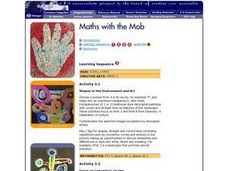Curated OER
The Tank
Students have a better grasp of the ecosystem of the St. Mary's river. They analyze how the tank is meant to be a miniature of the river. Students inquire how to take care of the tank and its inhabitants. They are introduced to Fundulus...
Curated OER
Aquifers and Recharge Areas
Students create a model of an aquifer and describe how an aquifer works. They describe how running affects an aquifer and prepare a model presenting to local planners the important aspects of protecting recharge areas.
Curated OER
Speleothem Formations
Students examine how speleothem formations can be simulated. Students follow directions carefully in this laboratory experiment, and keep a written account of everything they observe. After five days, the students share their experiment...
Curated OER
Factors affecting infiltration and runoff
Students investigate some of the factors that determine the amount of runoff. They are reminded that infiltration and runoff tend to work oppositely. When conditions are bad for infiltration they usually lead to runoff.
Curated OER
Separation of Mixtures and Compounds For K Through 12
Students explore mixtures and compounds. In this instructional activity, students do an experiment to distinguish between mixtures and compounds. Students complete ten different phases of the experiment testing many different substances....
Curated OER
Dynamic River Model
Students develop the concepts of flood stage, levees, floodplain, and the dynamics of river flooding. They construct river models and test various flow rates and volumes. This lesson has an excellent experiment for students to do.
Curated OER
Homogenous and Heterogeneous Mixtures
Fourth graders explain and describe what a mixture is, distinguish between the two types of mixtures (which are heterogeneous vs.homogenous) and are able to create and appropriately label mixtures.
Curated OER
Soil and Agriculture:Lesson 3 - Soil Erosion
Learners reseach the different types of soil erosion and ways to control it in this series of activities.
Curated OER
An Introduction to 'Opae 'ula
Students examine the 'opae 'ula. In this science lesson, students observe a live specimen and identify the major body parts. Students construct habitat jars and observe the 'opae 'ula behaviors.
Curated OER
Making a Soil Separator
Students investigate botany by creating a soil separating device. For this plant life lesson, students identify the needs of plants and how important the right soil is in the growing process. Students define different soil...
Curated OER
Count or Non Count Nouns
In this count and non count nouns learning exercise, students read the chart on how to identify count and non count nouns. Students then read examples of count and non count nouns.
Curated OER
Newton's Laws of Motion
Sixth graders explore Newton's laws of motion with their own bodies. In this relative motion lesson students will use a wide range of materials bringing them from the concrete to the abstract on video. Students will draw inferences about...
Curated OER
Fossil Formation
Students discuss fossils. In this science lesson, students simulate fossils within Earth's layers by using gummy fish and bread.
Curated OER
Minerals and You
Young scholars study how mineral are used in everything around us-- from cereal to satellites. After informing the students about minerals they will discuss the ones that are in the area of the young scholars.
Curated OER
Can You Control Floods
Students assume the role of an engineer or planner. As an engineer or planner they must come up with ideas that can be put into place to control floods. They produce a working model of flood control.
Curated OER
Moles, Stoichiometry, and Concentration
In this stoichiometry worksheet, students practice calculating moles, molar mass, and percentage composition of given compounds. This worksheet has 55 problems to solve.
Curated OER
Characteristics of Crystals
In this crystals worksheet, students complete a graphic organizer by filling in the characteristics of the different crystal types including melting/boiling point and electrical conductivity.
Curated OER
Ocean Floor Properties and Near Shore Environments
Pupils explore and model the characteristics of the ocean floor and near shore environments through in-class demonstrations, laboratory activities, and internet research. They use classroom materials to research the characteristics of...
Curated OER
Do-It-Yourself Fossils
For this fossils worksheet, students create their own casts, molds, imprints, and embedded fossils. Then students complete a fossil comparison chart. This worksheet has 12 fill in the blank questions.
Curated OER
Mixtures
In this mixtures worksheet, students fill in 7 blanks, determine if 4 statements are true or false, match 7 terms with the appropriate definitions, and solve 2 problems. These include topics such as homogeneous and heterogeneous...
Curated OER
The Chemistry of Mineral Worksheet
In this mineral worksheet, learners give the name and/or symbol for elements and they distinguish between elements and compounds. They fill in a chart with subatomic particles for given elements and they determine if given substances are...
Curated OER
ESL: An/An/Some
In this ESL a/an/some worksheet, students choose the correct article to place before given items, 40 total. A link to audio and additional resources is given.
Curated OER
Maths with the Mob - Aboriginal Culture
Students read and discuss books about aboriginal family life. Working individually and in groups, they complete a series of activities in various subject areas, including art, language, math, and social studies. Among the activities ...
Curated OER
Verbs: Is/Are
In this verb instructional activity, students complete sentences by filling in blanks with either is/are/there are/there is. A reference web site for additional resources is given.























